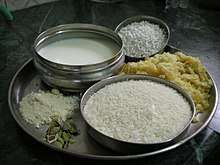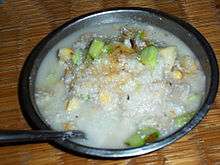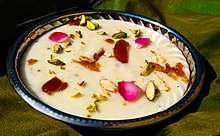Kheer
 Kheer | |
| Alternative names | Payasam, payasa, ksheeram, fereni and Kheer |
|---|---|
| Place of origin | Indian subcontinent |
| Region or state | India, Pakistan, Bangladesh, Bhutan, and Nepal[1] |
| Main ingredients | Rice, milk, sugar, cardamom, saffron, pistachios or almonds |
| Variations | Barley kheer, Kaddu ki kheer, paal (milk), payasam, payesh |
| 249 kcal[2] kcal | |
Kheer or Kiru (Maldivian: ކިރު) is a rice pudding popular in Indian subcontinent, made by boiling rice, broken wheat, tapioca, or vermicelli with milk and sugar; it is flavoured with cardamom, raisins, saffron, cashews, pistachios or almonds. It is typically served during a meal or as a dessert. It is also known in some regions as payasam, payasa, and phirni,[3] while in Bengal the payesh is a variation of Kheer.
Names
The Sanskrit name is क्षीर kṣīra/ पायसम् "paayasam". In Hindi and Marathi, खीर khīr; Punjabi, کھیر/ਖੀਰ; Odia, ଖିରି khiri; Sindhi, کھیر; Urdu, کھیر; Dhivehi, ކިރު "kiru"; and Nepali: खिर. It is also known as payasam (Tamil: பாயாசம், Telugu: పాయసం, Malayalam: പായസം), payasa (Kannada: ಪಾಯಸ), payesh (Bengali: পায়েস), faesh (Sylheti: ꠙꠣꠄꠡ), payox (Assamese: পায়স), or Paays (पायस) in Konkani. The word payasam is derived from payasa, meaning "milk".[4] In Gujarati, it is often called dūdpāk, દઉદપઅક. It is also known as firni in some parts of Sylhet and Iran as Ferni (فرنی).
Regional variations


Kheer is prepared in festivals, temples, and all special occasions. The term kheer (used in North India) may derive from the Sanskrit word Ksheera (which means "milk").[5][6] Other terms like Payasam or payesh (used in the Bengal region) are derived from the Sanskrit word Payasa or Payasam, which also means "milk". It is prepared using milk, rice, ghee, sugar/jaggery, and khoya. Some also add a little bit of heavy cream for a richer taste. It is often garnished using almonds, cashews, raisins and pistachios. There is one more popular version of North Indian kheer, prepared during festivals and havan in Varanasi by using only milk, rice, ghee, sugar, cardamom, dried fruit, and kesar (saffron milk). It is an essential dish in many Hindu feasts and celebrations. While the dish is most often made with rice, it can also be made with other ingredients, such as vermicelli (semiya in South India, seviyan, seviyaan, sayviah, or other spellings) or Tapioca (locally known as sabudana).
Rice was known to the Romans, and possibly introduced to Europe as a food crop, dating as early as the 8th or 10th Century AD,[7] and so the recipe for the popular English rice pudding is believed by some to be descended from kheer.[5] Similar rice recipes (originally called potages) go back to some of the earliest written recipes in English history.[8]
East Indian version
.jpg)
The Odia version of rice kheer (Payas in Northern Odisha) likely originated in the city of Puri, in Odisha more than 2,000 years ago.[9][10] It is cooked to this day within the temple precincts there. Every single day, hundreds of temple cooks work around 752 hearths in what is supposed to be the world's largest kitchen to cook over 100 different dishes, including kheer, enough to feed at least 10,000 people.
Payas is also regarded as an auspicious food and generally associated with annaprashana (weaning ritual of an infant), as well as other festivals and birthday celebrations in an Odia household.
Although white sugar is commonly used, adding Gurh (jaggery) as a sweetener, is an interesting and extremely delicious variation prepared in Bengal and Odisha, especially during winter and spring when fresh gurh is available.
In Bengal, it is called payas or payesh. A traditional Bengali meal can be traced 2000 years old and it is one of important sweet dish payas followed by other sweets.
Payesh is also regarded as an auspicious food and generally associated with annaprashana (weaning ritual of an infant) and Janmatithi (birthday) in a Bengali household. It is called kheer in Bengali if milk is used in a significantly greater amount than rice. The people of West Bengal and Bangladesh prepare payesh with gurh, ketaki, glutinous rice, vermicelli, semolina and coconut milk, and the result is a stickier and creamier dessert.
In Assam, it is called payoxh and in addition to other dried fruits, cherries are added to give it a light delicate pink colour. Sometimes rice may be replaced with sago. It is one of the most significant desserts served in Assamese families and quite often a part of religious ceremonies.
In Bihar, it is called "Chawal ki Kheer".[11] It is made with rice, full fat cream, milk, sugar, cardamom powder, an assortment of dried fruits, and saffron. Another version of this kheer, called Rasiya, is made with jaggery. Jaggery is used instead of sugar in the process. The jaggery version looks brown in color and has a mild, sweet taste.
South Indian version

The South Indian version, payasam (Tamil: பாயசம், Malayalam: പായസം, pronounced [paːjəsəm], Telugu: పాయసం) or payasa (a Kannada term; Kannada: ಪಾಯಸ), is an integral part of traditional South Indian meals. South Indian payasam also makes extensive use of jaggery (Tamil: வெல்லம் vellam, Telugu: బెల్లం bellam, Kannada: ಬೆಲ್ಲ bella, Malayalam: ശർക്കര sharkkara) and coconut milk in place of sugar and milk. Vermicelli (semiya) is commonly used. The most common types of payasam in South India include Pal (milk) payasam, Javvarisi (sago/tapioca pearl) payasam, Semiya (vermicelli) payasam, Paruppu (dhal) payasam, Nei (ghee) payasam (also known as Aravana payasam), Carrot payasam, Wheat payasam, Wheat rava (wheat semolina) payasam, and Arisi Thengai (coconut and rice) payasam, which is a traditional Iyengar-style recipe.
In a South Indian meal, payasam or payasa, is served first at any formal or auspicious occasion. Payasam is also served after rasam rice, while rice with buttermilk forms the last item of the meal.[12] Payasam also forms an integral part of the Kerala feast (sadya), where it is served and relished from the flat banana leaf instead of cups. In Malayalee or Kerala cuisine, there are several different kinds of payasam that can be prepared from a wide variety of fruits and starch bases, an example being chakkapradhaman made from jackfruit pulp and adapradhaman made from flat ground rice.
The Hyderabadi version is called gil-e-firdaus. It is a thick kheer made with milk and bottle gourd. Gil-e-firdaus, literally translated, means "the clay of paradise".
Payasam is served as an offering to the Gods in South Indian Hindu temples during rituals and ceremonies. In Kerala, Ambalapuzha Pal Payasam (Milk Kheer) is a famous payasam.
Regional versions

Across the Subcontinent, kheer is prepared and eaten at festivals. It is offered to Hindu deities as a bhog or prasadam.
The dish is also consumed during Ramadan and prepared for the feasts of Muslim weddings and festivals, such as Eid ul-Fitr and Eid ul-Adha.
A similar dessert, known as firni, is eaten in Iran, Azerbaijan, Afghanistan and among the Muslim communities of India, Bangladesh and Pakistan. Today, restaurants offer firni in a wide range of flavours, similar to kheer. Firni used ground rice rather than whole rice.
See also
References
- ↑ "Bengali Payesh – Rice Kheer Recipe". Kfoods.com. Retrieved June 28, 2014.
- ↑ "Archived copy". Archived from the original on 2015-05-10. Retrieved 2014-06-28.
- ↑ "Rice Kheer". Nestle Dessert Arabia. Retrieved 17 August 2018.
- ↑ "payasam - Definition of payasam in English by Oxford Dictionaries". Oxford Dictionaries - English. Retrieved 17 August 2018.
- 1 2 "Dessert! Kheer!". Eastern Aromas (Blog). Archived from the original on 2010-11-04. Retrieved 2008-05-30.
- ↑ Bahadur, Om Lata (1996). The book of Hindu festivals and ceremonies (3rd ed.). New Delhi: UBS Publishers Distributors ltd. p. 173. ISBN 81-86112-23-5.
- ↑ "WHKMLA : The History of Rice Cultivation in Europe". Zum.de. Retrieved 17 August 2018.
- ↑ Hieatt, Constance; Sharon Butler (1985). Curye on Inglysch. Early English Text Society. pp. 64, 68, 75. ISBN 0-19-722409-1.
- ↑ "Cooking With Kurma - Essays". Kurma.net. Retrieved 17 August 2018.
- ↑ "The many faces of Kheer: Think the famous rice pudding is an Indian invention? You will be surprised!". Indianexpress.com. 10 November 2014. Retrieved 17 August 2018.
- ↑ KhanaPakana.Com. "Chawal Ki Kheer recipes - KhanaPakana.com". Khanapakana.com. Retrieved 17 August 2018.
- ↑ "Sadya - the traditional vegetarian feast of Keralites". Kerala Tourism. Retrieved 17 August 2018.


